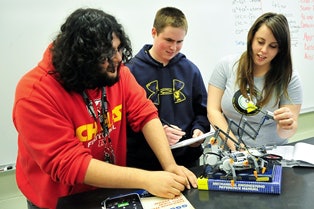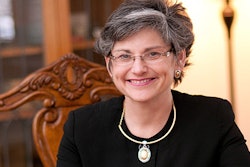 San Jacinto College math students, from left, Miguel Rosales, Harrison Mast and Darby Macha, participate in a robotics lab during Tech Friday.
San Jacinto College math students, from left, Miguel Rosales, Harrison Mast and Darby Macha, participate in a robotics lab during Tech Friday.As the No. 3 city for the most tech job growth in the last decade, Houston is shaping up to be a hub of not only industry but STEM education.
Overall, the city saw a 24.1 percent jump in STEM careers from 2001 to 2013, according to a Praxis Strategy Group survey, a number that many educators in the area say they are aware of and impacts their work.
“I think the need for more STEM workers is both a local and national issue,” says Dr. Alexander Okwonna, dean of health and natural sciences at San Jacinto College, located in the Houston metro area. “Globally, for the United States to keep up with the rest of the world, we’re going to have to step up the number of student graduates, and to do that we’re going to need more women and minorities to come on board and go into STEM careers.”
STEM initiatives
Nationally, the number of STEM jobs has increased 30 percent since 2000, according to the U.S. News/Raytheon STEM Index. To keep up with demand, administrators, faculty and staff created a group, the San Jacinto College STEM Council, to coordinate STEM efforts across the two-year college’s three campuses.
“There are three guiding principles that we are going by: recruit, retain and reward,” notes Okwonna.
A year and a half into the creation of the council, Dr. Ann Cartwright, a chemistry professor and council co-chair, says the council is doing everything it can “dream up” to streamline efforts for its mostly underserved minority student body.
“There have been a lot of nuts and bolts to work out this first year,” she says, adding that the academic year kicked off with a fundraising cocktail at the Houston Museum of Natural Science to create a scholarship program for STEM students.
With this financial backing, the STEM Council went on to focus on myriad issues facing students, always with an eye on catering to each and every student’s needs, Cartwright says.
“In a science class — the [really] math intensive courses — we will cap it at 30,” she says. This allows for more one-on-one attention from the instructor, Cartwright notes. She maintains the smaller class sizes have even attracted STEM students from area four-year schools looking to avoid the 100-plus class sizes in challenging introductory courses.
“We’re able to reach a lot of students that the universities are notable to reach. We’re just trying whatever! If it is a reading deficiency, we’ll work on that. If it’s a math deficiency, we’ll work on that,” says Cartwright.
Another service that has made a substantial difference is Open Labs, a program that has been offering additional aid to help students understand concepts outside of the actual lab for a course.
“We’re seeing a letter grade difference … for students who attend an Open Lab,” says Okwonna, who sees this as a key part of the school’s retention strategy.
While she cites data such as 38 percent of STEM students drop out of their program in college, Cartwright says she is not discouraged. She says she focuses on helping students to see the career opportunities in STEM fields.
“I read a survey that the American College Testing service put out for high school students and for their parents. The question, ‘Why are you not going into STEM or are not interested in STEM?’ came up and there were two or three major reasons [for answering no.]
“[One of them was that] they thought high schools were not preparing them adequately to go into STEM,” says Cartwright. “I’ve been a chemistry teacher at San Jac for 35 years, and I have found that no matter what their background is in science, that if they have math skills … they can start with the science.”
Still, she insists, succeeding in a STEM program does not take fantastic grades in high school. “It just takes hard work and ‘stick-to-itiveness,’” says Cartwright.
Roping STEM majors
One of the ways the school is roping in STEM majors is by engaging them in service learning activities with area elementary, middle and high schools.
“When they are teaching concepts to children or high school students and helping them do a laboratory experiment — it may not be the same topics they are studying in the [classroom] — I think it’s just that extra interest. A lot of our students have never been a role model for anyone, and these little kids treat them like rock stars, so it is fantastic for their self-esteem to be in a leadership position.”
Indeed, teaching younger students STEM concepts has had double results — it’s serving as a pipeline program, exposing a future student body to math and science. “We really, really work hard in recruiting. We target elementary all the way to high school,” says Okwonna.
An Early College program the school started seven years ago with area students at a predominantly Hispanic school has already started to pay off. Now there are four Early College High Schools (ECHS): Clear Horizons, Pasadena, Sheldon and the Modified Early College Academy. Clear Horizons Early College High School was established in 2007, Pasadena ECHS in 2010 and Sheldon ECHS in 2012.
“Such opportunities pique their interest, as they are allowed to come onto our campuses and work alongside their college peers in an actual college science environment and lab,” says Okwonna.
In addition, bringing in outside speakers from Rice University and other local institutions has helped retain students, giving them an opportunity to see where their education could take them. San Jacinto also recently launched a program, Tech Friday, with the University of Houston Clear Lake, to stimulate competition and learning among STEM majors.
This initiative includes computer programming, robotics activities and math-intensive elements.
“We’re really good at student recruitment, and UHCL works with our students who transfer to help them complete degrees, so it makes for a natural partnership,” says Nate Wiggins, a math and engineering professor at San Jacinto.
For civil and mechanical engineering students, San Jacinto also offers two years of classes, allowing enrollees to then matriculate at the University of Texas at Tyler for a bachelor’s degree. The college has also worked to open students’ eyes to baccalaureate offerings and programs at UT MD Anderson and Texas A&M.
“It’s not necessarily about students being underprepared … it’s more about students needing the awareness of STEM careers and also providing mentors,” says Okwonna. “Even the gifted students, if they don’t have a living example, their goal becomes a little bit abstract. When you provide them a faculty member who can share with them personal knowledge and help them get into a STEM career, it absolutely changes their life.”
According to 2010 data from the National Science Foundation, underrepresented minorities earned only 18 percent of four-year degrees in science fields.
Learning support services, extra tutoring and even extracurricular activities like the social groups Ladies of Integrity and Men of Honor are all part of the equation for success, he adds.
While just 26 percent of ACT-taking students in 2013 met all college readiness requirements and about 36 percent did in science, overall Cartwright says she believes policymakers have been too focused on what incoming STEM students are lacking and not focusing on how to build up the skills they already have.
“A lot of the things that people worry about are not the right things to be worrying about,” she says. “Saying they don’t have an adequate high school background is, in my opinion, not valid.”



















